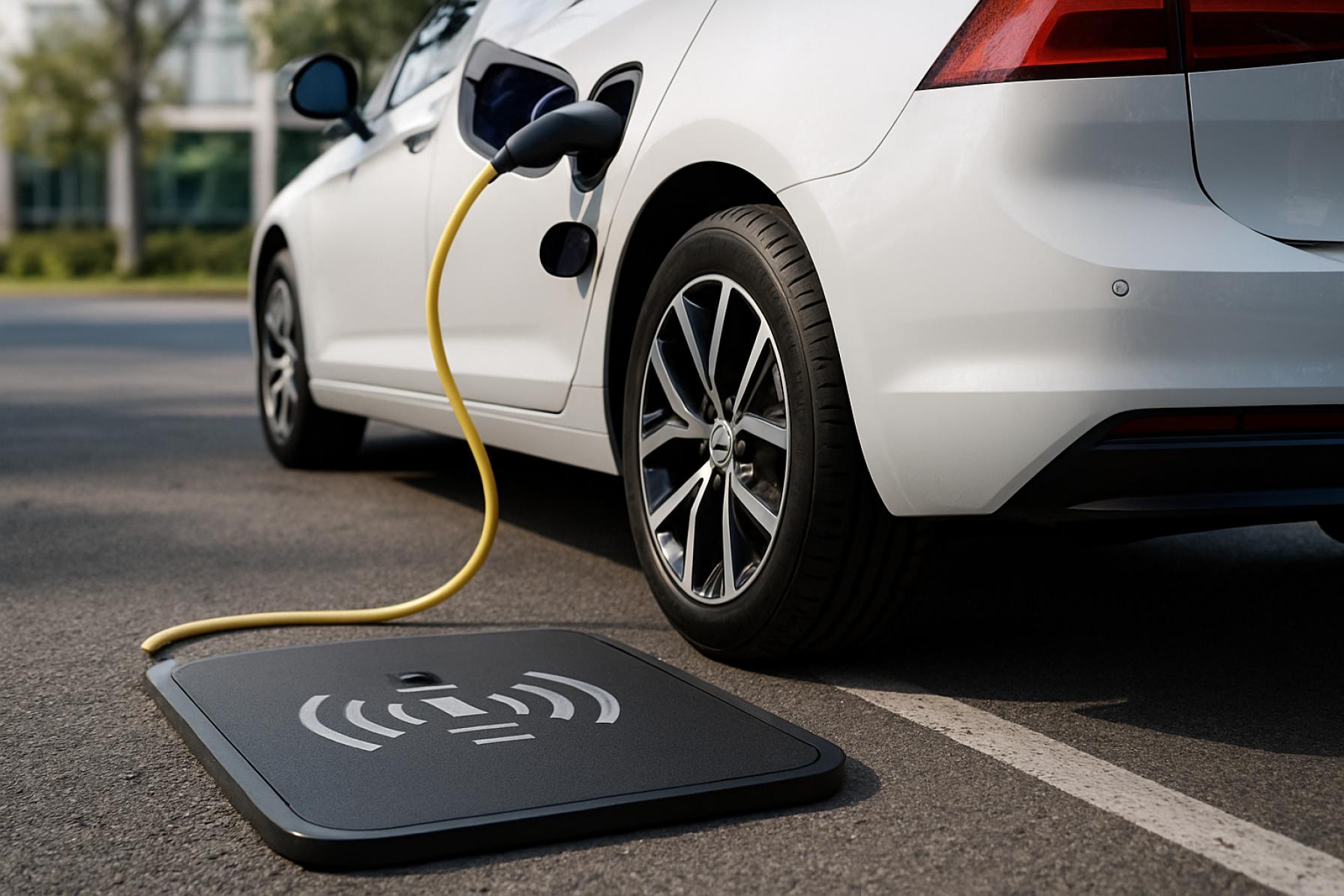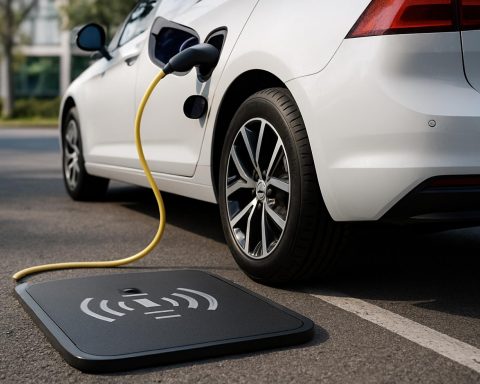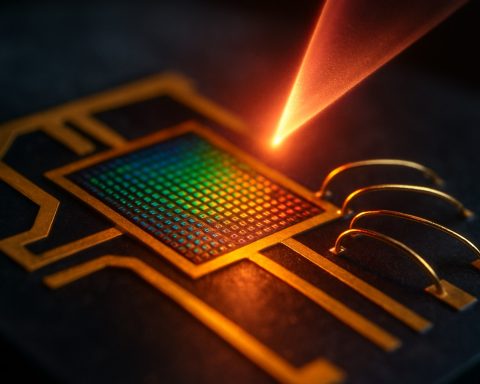Wireless Power Transfer Systems for Electric Vehicles 2025: In-Depth Market Analysis, Growth Projections, and Key Technology Trends. Discover Opportunities, Regional Leaders, and the Road Ahead for Next-Gen EV Charging.
- Executive Summary & Market Overview
- Key Technology Trends in Wireless EV Power Transfer
- Competitive Landscape and Leading Players
- Market Growth Forecasts (2025–2030): CAGR, Revenue, and Volume Analysis
- Regional Market Analysis: North America, Europe, Asia-Pacific, and Rest of World
- Challenges, Risks, and Barriers to Adoption
- Opportunities and Strategic Recommendations
- Future Outlook: Innovations and Market Evolution
- Sources & References
Executive Summary & Market Overview
Wireless Power Transfer (WPT) systems for electric vehicles (EVs) represent a transformative technology aimed at enhancing the convenience, safety, and efficiency of EV charging. By enabling contactless energy transfer between a charging pad and a vehicle, WPT systems eliminate the need for physical connectors, reducing wear and tear and improving user experience. As of 2025, the global market for wireless EV charging is experiencing robust growth, driven by increasing EV adoption, advancements in power electronics, and supportive regulatory frameworks.
According to IDTechEx, the wireless EV charging market is projected to reach over $1.5 billion by 2025, with a compound annual growth rate (CAGR) exceeding 40% from 2020 to 2025. This surge is fueled by pilot deployments in public transit, premium passenger vehicles, and commercial fleets, as well as ongoing standardization efforts by organizations such as the SAE International (SAE J2954 standard).
Key industry players—including Qualcomm (Halo), WiTricity, BMW Group, and Tesla—are actively investing in R&D and pilot programs to commercialize WPT solutions. Notably, WiTricity has partnered with several automakers to integrate wireless charging into next-generation EV models, while BMW Group has launched limited wireless charging pilots in Europe and the US.
Geographically, Europe and North America are leading in early adoption, supported by government incentives and urban electrification initiatives. Asia-Pacific, particularly China and South Korea, is rapidly catching up, with significant investments in smart infrastructure and public transit electrification (MarketsandMarkets).
- Market Drivers: Rising EV sales, urbanization, and the push for autonomous vehicles.
- Challenges: High initial costs, interoperability concerns, and the need for standardized infrastructure.
- Opportunities: Integration with smart grids, dynamic (in-motion) charging, and fleet applications.
In summary, the wireless power transfer market for EVs in 2025 is characterized by rapid innovation, strategic partnerships, and a clear trajectory toward mainstream adoption, positioning it as a critical enabler of the future electric mobility ecosystem.
Key Technology Trends in Wireless EV Power Transfer
Wireless Power Transfer (WPT) systems for electric vehicles (EVs) are rapidly evolving, driven by the need for greater convenience, efficiency, and integration with smart infrastructure. In 2025, several key technology trends are shaping the development and deployment of WPT solutions for EVs, with a focus on both stationary and dynamic charging scenarios.
- Resonant Inductive Coupling Advances: The dominant technology for wireless EV charging remains resonant inductive coupling, which enables efficient energy transfer across air gaps. Recent innovations have improved alignment tolerance and power transfer efficiency, with leading manufacturers such as Qualcomm and WiTricity demonstrating systems capable of 11 kW and higher, rivaling traditional plug-in chargers.
- Standardization and Interoperability: The push for global standards, such as SAE J2954, is accelerating. These standards ensure interoperability between vehicles and charging pads from different manufacturers, reducing market fragmentation and fostering broader adoption. SAE International and IEC are at the forefront of these efforts.
- Dynamic Wireless Charging: Dynamic WPT, which allows EVs to charge while in motion, is gaining traction. Pilot projects in Europe and Asia, such as those led by ENEA and KAIST, are demonstrating the feasibility of embedding charging coils in roadways, potentially reducing battery size requirements and range anxiety.
- Integration with Smart Grids and V2G: WPT systems are increasingly being designed to support bidirectional energy flow, enabling vehicle-to-grid (V2G) applications. This integration allows EVs to act as distributed energy resources, supporting grid stability and renewable energy adoption, as highlighted by NREL research.
- Enhanced Safety and Cybersecurity: As wireless charging becomes more widespread, safety protocols and cybersecurity measures are being strengthened. Advanced foreign object detection, living object protection, and secure communication protocols are being implemented to address regulatory and consumer concerns, as noted by UL Solutions.
These trends indicate that by 2025, wireless power transfer systems for EVs will be more efficient, interoperable, and integrated with broader energy and transportation ecosystems, paving the way for mainstream adoption and new business models in the EV charging market.
Competitive Landscape and Leading Players
The competitive landscape for wireless power transfer (WPT) systems in electric vehicles (EVs) is rapidly evolving, driven by increasing EV adoption, advancements in charging infrastructure, and the push for greater convenience and efficiency. By 2025, the market is characterized by a mix of established automotive suppliers, technology innovators, and strategic partnerships between automakers and electronics companies.
Key players in the WPT for EVs market include Qualcomm (through its Halo technology, now licensed to WiTricity), Tesla, Inc., BMW Group, Daimler AG (Mercedes-Benz), Toyota Motor Corporation, and ZF Friedrichshafen AG. These companies are investing heavily in R&D to improve charging efficiency, interoperability, and safety standards.
WiTricity, a pioneer in magnetic resonance-based wireless charging, has emerged as a technology leader, licensing its intellectual property to major automakers and infrastructure providers. The company’s partnerships with Hyundai Motor Company and Toyota have resulted in pilot deployments and demonstration projects, particularly in Asia and North America. Meanwhile, BMW and Daimler have launched wireless charging options for select plug-in hybrid models, targeting premium customers seeking convenience and innovation.
Startups and niche players, such as Plugless Power (Evatran) and EnergySquare, are also contributing to the competitive landscape by offering aftermarket solutions and collaborating with fleet operators. These companies focus on retrofitting existing EVs and providing wireless charging pads for commercial and residential use.
Strategic alliances are shaping the market, with automakers partnering with infrastructure providers and municipalities to pilot dynamic wireless charging on public roads. For example, Stellantis has tested dynamic charging in Italy, while Volkswagen AG is exploring similar initiatives in Germany. These collaborations aim to address range anxiety and support the broader adoption of EVs.
Overall, the 2025 competitive landscape is defined by technological innovation, intellectual property licensing, and cross-industry partnerships, with leading players vying to set industry standards and capture early market share in the wireless EV charging segment.
Market Growth Forecasts (2025–2030): CAGR, Revenue, and Volume Analysis
The wireless power transfer (WPT) systems market for electric vehicles (EVs) is poised for robust growth in 2025, driven by increasing EV adoption, advancements in charging infrastructure, and supportive regulatory frameworks. According to projections by MarketsandMarkets, the global wireless EV charging market is expected to register a compound annual growth rate (CAGR) of approximately 45% from 2025 to 2030. This rapid expansion is underpinned by the growing demand for convenient, cable-free charging solutions and the integration of WPT technology in both passenger and commercial EV segments.
Revenue forecasts for 2025 indicate that the global market for wireless EV charging systems will surpass USD 300 million, with North America and Europe leading in early adoption due to strong government incentives and the presence of key industry players such as Qualcomm, WiTricity, and BMW Group. By 2030, the market is projected to reach over USD 2 billion, reflecting the scaling of pilot projects into commercial deployments and the expansion of public and fleet charging infrastructure.
In terms of volume, the number of wireless charging units installed globally is expected to grow from fewer than 10,000 units in 2025 to over 100,000 units by 2030, according to IDTechEx. This surge will be fueled by the deployment of wireless charging pads in residential, commercial, and public parking spaces, as well as the integration of dynamic wireless charging in select urban transit corridors.
- Passenger Vehicles: The passenger EV segment will account for the largest share of revenue and volume, as automakers increasingly offer factory-installed wireless charging options and aftermarket solutions gain traction.
- Commercial Fleets: Fleet operators, particularly in logistics and public transportation, are expected to drive significant demand for high-power WPT systems, leveraging the technology for operational efficiency and reduced downtime.
Overall, the 2025–2030 period will mark a transition from pilot-scale deployments to mainstream adoption, with WPT systems becoming a critical enabler of seamless, user-friendly EV charging experiences. The market’s trajectory will be shaped by ongoing technological innovation, cost reductions, and the alignment of industry standards, as highlighted by International Energy Agency analyses.
Regional Market Analysis: North America, Europe, Asia-Pacific, and Rest of World
The regional market landscape for wireless power transfer (WPT) systems in electric vehicles (EVs) is evolving rapidly, with distinct trends and growth drivers across North America, Europe, Asia-Pacific, and the Rest of the World (RoW).
- North America: The North American market, led by the United States, is characterized by robust investments in EV infrastructure and a strong focus on technological innovation. Government incentives and pilot projects, such as those supported by the U.S. Department of Energy, are accelerating the deployment of WPT systems. Major automakers and technology firms are collaborating to integrate wireless charging into public and private charging networks. The region is expected to see a CAGR of over 35% through 2025, driven by increasing EV adoption and the push for convenient, user-friendly charging solutions (IDTechEx).
- Europe: Europe’s WPT market is propelled by stringent emissions regulations and ambitious electrification targets set by the European Commission. Countries like Germany, France, and the Netherlands are piloting dynamic wireless charging on public roads and integrating WPT into urban mobility projects. The presence of leading automotive OEMs and technology providers, such as BMW Group and Siemens, further accelerates market growth. By 2025, Europe is anticipated to account for a significant share of global WPT installations, particularly in fleet and public transport segments (MarketsandMarkets).
- Asia-Pacific: The Asia-Pacific region, led by China, Japan, and South Korea, is the fastest-growing market for WPT systems. Aggressive government policies, high EV penetration, and large-scale smart city initiatives are key growth drivers. China’s focus on next-generation charging infrastructure and Japan’s early adoption of wireless charging in public and residential settings are notable. The region is expected to witness the highest installation rates by 2025, supported by investments from companies like Toyota Motor Corporation and Honda Motor Co., Ltd. (Fortune Business Insights).
- Rest of World (RoW): In regions such as the Middle East, Latin America, and Africa, the WPT market is nascent but growing. Adoption is primarily driven by pilot projects and partnerships with global technology providers. While infrastructure challenges persist, increasing interest in sustainable mobility and government-led electrification programs are expected to create new opportunities through 2025 (Allied Market Research).
Challenges, Risks, and Barriers to Adoption
Wireless power transfer (WPT) systems for electric vehicles (EVs) promise significant convenience and efficiency gains, but their widespread adoption faces several challenges, risks, and barriers as of 2025. These issues span technical, economic, regulatory, and social domains, impacting both manufacturers and end-users.
- Technical Challenges: Achieving high energy transfer efficiency remains a core technical hurdle. Most commercially available WPT systems operate at efficiencies lower than traditional plug-in charging, especially when misalignment occurs between the vehicle and charging pad. This misalignment sensitivity can lead to energy losses and slower charging times, as highlighted by International Energy Agency. Additionally, electromagnetic interference (EMI) and safety concerns regarding human exposure to electromagnetic fields require robust mitigation strategies and compliance with evolving standards.
- Infrastructure and Standardization: The lack of universal standards for WPT systems impedes interoperability between different vehicle models and charging infrastructure. Competing standards from organizations such as SAE International and International Electrotechnical Commission create uncertainty for automakers and infrastructure providers, slowing investment and deployment.
- Cost Barriers: The initial cost of WPT hardware, including both vehicle-side receivers and ground-side transmitters, is significantly higher than conventional charging solutions. Installation of in-ground charging pads, especially for public or dynamic (in-motion) charging, involves substantial civil engineering work and ongoing maintenance costs. According to IDTechEx, these costs are a major deterrent for fleet operators and municipalities.
- Regulatory and Safety Risks: Regulatory frameworks for WPT are still evolving, with many regions lacking clear guidelines on electromagnetic field exposure, grid integration, and safety certification. This regulatory uncertainty can delay project approvals and market entry, as noted by International Energy Agency.
- Consumer Acceptance: End-user awareness and trust in WPT technology are still developing. Concerns about reliability, safety, and the perceived complexity of new charging methods may slow adoption, particularly among private consumers compared to commercial fleets.
Addressing these challenges will require coordinated efforts across industry, government, and standardization bodies to ensure that WPT systems for EVs can achieve their full market potential in the coming years.
Opportunities and Strategic Recommendations
The wireless power transfer (WPT) systems market for electric vehicles (EVs) is poised for significant growth in 2025, driven by increasing EV adoption, advancements in charging infrastructure, and supportive regulatory frameworks. Key opportunities and strategic recommendations for stakeholders in this sector are outlined below.
- Expansion of Public and Commercial Charging Networks: As urban centers and commercial fleets transition to electric mobility, there is a growing demand for convenient, high-throughput charging solutions. WPT systems offer seamless, cable-free charging for taxis, buses, and delivery vehicles, reducing downtime and operational complexity. Strategic partnerships with municipalities and fleet operators can accelerate deployment and adoption. According to International Energy Agency, public charging infrastructure is a critical enabler for EV market growth.
- Integration with Smart Grids and V2G Technologies: WPT systems can be integrated with smart grid and vehicle-to-grid (V2G) technologies, enabling dynamic load management and grid stabilization. Companies should invest in interoperable solutions that support bidirectional energy flow, aligning with the global push for grid resilience and renewable energy integration, as highlighted by National Renewable Energy Laboratory.
- Standardization and Interoperability: The lack of universal standards remains a barrier to widespread WPT adoption. Industry players should actively participate in standardization initiatives led by organizations such as SAE International and IEEE to ensure compatibility across vehicle models and charging infrastructure, reducing market fragmentation and fostering consumer confidence.
- Focus on High-Efficiency and Cost-Effective Solutions: Technological advancements in resonant inductive and capacitive coupling are improving WPT efficiency and reducing system costs. R&D investments should prioritize minimizing energy losses and enhancing power transfer rates, as recommended by IDTechEx in their market analysis.
- Targeted Marketing and Consumer Education: Consumer awareness of WPT benefits—such as convenience, safety, and reduced wear on connectors—remains limited. Strategic marketing campaigns and pilot programs can demonstrate real-world advantages, accelerating market acceptance.
In summary, the 2025 landscape for wireless power transfer systems in EVs presents robust opportunities for growth. Stakeholders should focus on infrastructure partnerships, technological innovation, standardization, and consumer engagement to capture emerging value pools and establish market leadership.
Future Outlook: Innovations and Market Evolution
The future outlook for wireless power transfer (WPT) systems in electric vehicles (EVs) is marked by rapid innovation and evolving market dynamics as the industry approaches 2025. Key advancements are expected in both static and dynamic wireless charging technologies, with a focus on improving efficiency, interoperability, and scalability to support broader EV adoption.
One of the most significant innovations is the development of higher-power wireless charging systems, capable of delivering up to 22 kW or more, which can rival the speed of conventional wired fast chargers. Companies such as Qualcomm and WiTricity are leading efforts to commercialize magnetic resonance-based solutions that offer greater alignment tolerance and efficiency, reducing the need for precise vehicle positioning over charging pads.
Dynamic wireless charging—where vehicles are charged while in motion on specially equipped roadways—is also gaining traction. Pilot projects in Europe and Asia, such as those supported by ENEA and KAIST, are demonstrating the feasibility of this technology for public transit and commercial fleets. By 2025, further deployments are anticipated, particularly in urban corridors and logistics hubs, as governments and municipalities seek to reduce emissions and support electrified transportation infrastructure.
Standardization is another critical area of evolution. The SAE International J2954 standard, which defines interoperability and safety requirements for wireless EV charging, is expected to see broader adoption, enabling cross-brand compatibility and fostering consumer confidence. Automakers such as BMW Group and Mercedes-Benz are already integrating compliant systems into select models, signaling a shift toward mainstream availability.
Market forecasts suggest robust growth for the WPT sector. According to IDC and MarketsandMarkets, the global wireless EV charging market is projected to reach multi-billion-dollar valuations by 2025, driven by increasing EV sales, urbanization, and supportive regulatory frameworks. Strategic partnerships between technology providers, automakers, and infrastructure operators will be pivotal in scaling deployment and reducing costs.
In summary, the 2025 outlook for wireless power transfer systems in EVs is characterized by technological breakthroughs, expanding pilot programs, and a maturing regulatory environment, all of which are set to accelerate the transition toward seamless, cable-free electric mobility.
Sources & References
- IDTechEx
- Qualcomm
- WiTricity
- MarketsandMarkets
- ENEA
- KAIST
- NREL
- UL Solutions
- Daimler AG
- Toyota Motor Corporation
- ZF Friedrichshafen AG
- Hyundai Motor Company
- EnergySquare
- Stellantis
- Volkswagen AG
- International Energy Agency
- European Commission
- Siemens
- Fortune Business Insights
- Allied Market Research
- IEEE
- IDC













